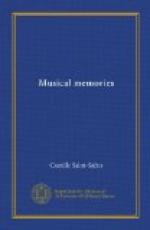Liszt was far from professing the disdain for the limitations of the human voice that Wagner and Berlioz did. On the contrary he treated it as if it were a queen or a goddess, and it is to be regretted that his tastes did not lead him to work for the stage. Parts of Saint Elisabeth show that he would have succeeded and the fashion of having operas for the orchestra, accompanied by voices, which we enjoy to-day, might have been avoided. He discovered a method, peculiarly his own, of writing choruses. His manner has never been imitated, but it is ingenious and has many advantages. The only trouble about it is that the singers have to take care of details and shadings which is too often the least of their worries. The German societies, where the members sing for pleasure, and not for a salary, are careful to excess, if there can be excess in such matters, and it is their great good fortune to be the interpreters of choruses written in this manner.
It is impossible to give an analysis of this vast work here. We have already spoken of the charming interlude, Les Bergers a la Creche. This pastoral is followed by Marche des Rois Mages, a pretty piece, but a little overdeveloped for its intrinsic worth. The vocal parts, Beatitudes and Le Pater Noster, would be more suitable in a church than in a concert hall. Then come some most brilliant pages, La Tempete sur le lac de Thiberiade, and Le Mont des Oliviers, with its baritone solo, and finally, the Stabat Mater, where great beauties are combined with terrible length. But nothing in the whole work impressed me more than Christ’s entrance to Jerusalem (orchestra, chorus, and soloist) for the reading alone gives no idea of it. Here the author reached the heights. That also describes the delightful effect of the children’s chorus singing in the distance O Filii et Filiae, harmonised with perfect taste.
While I listened to this beautiful work, I could not help thinking of the great oratorios which crowned Gounod’s musical career so gloriously. Liszt and Gounod differed entirely in their musical temperaments, yet in their oratorios they met on common ground. In both there was the same drawing away from the old forms of oratorio, the same search for realism in the expression of the text in music, the same respect for Latin prosody, and the same belief in simplicity of style. But while there is renunciation in the simplicity of Liszt, who threw aside worldly finery to wear the frock of a penitent, on the contrary Gounod appears to return to his original bent with an almost holy joy. This is easily explained. Liszt finished his life in a cassock, while Gounod began his in one. So, despite Liszt’s superior refinement, and putting aside exceptional achievements, in this branch of art Gounod was the victor. As there is an odor di femina there is a parfum d’eglise, well known to Catholics. Gounod’s oratorios are impregnated with this, while it is found in Christus very, very feebly, if at all. The Missa Solemnis must be examined to find it to any extent in Liszt’s work.




